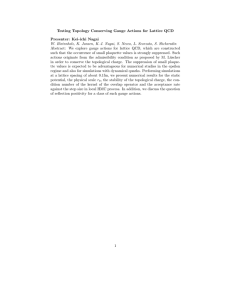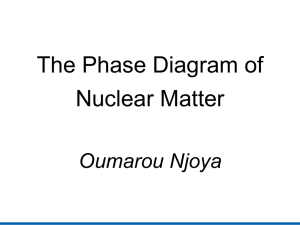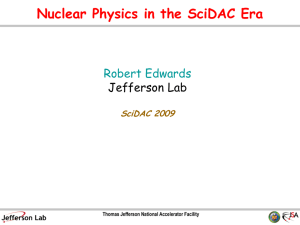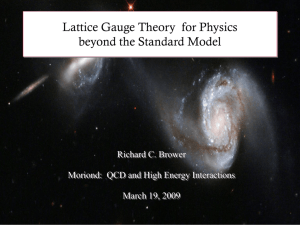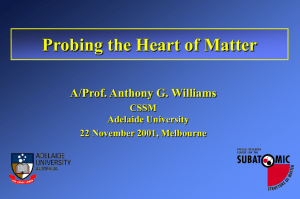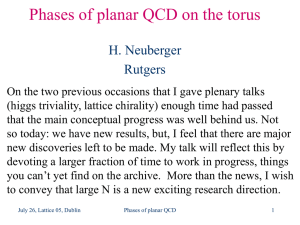New frontiers - Florence Theory Group
advertisement
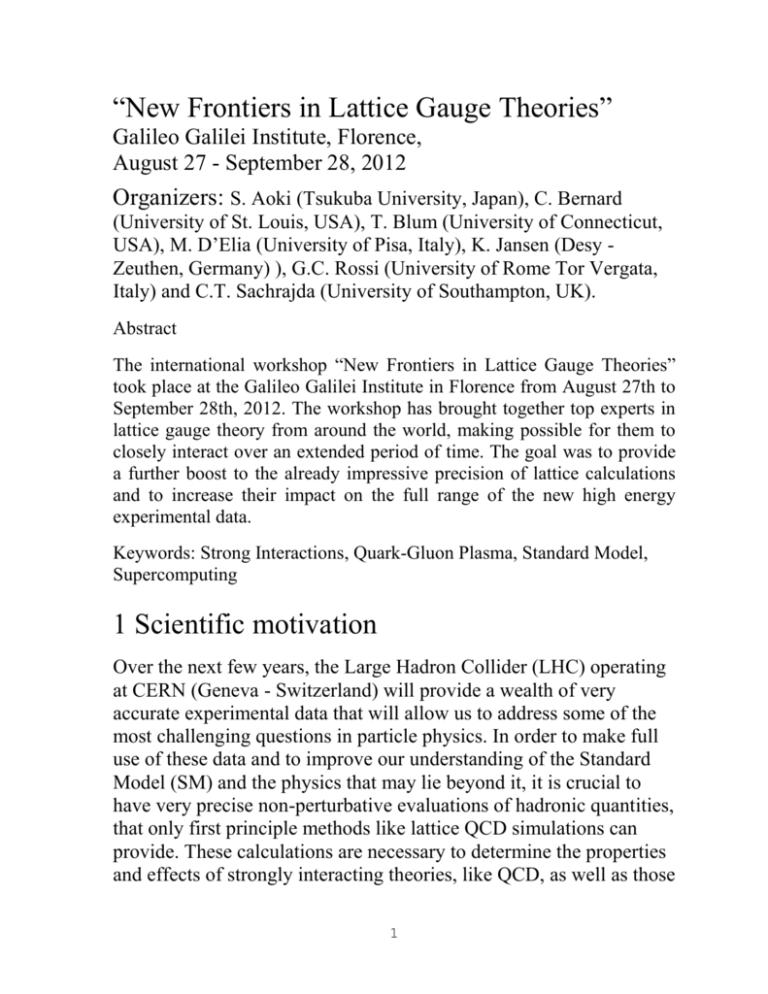
“New Frontiers in Lattice Gauge Theories” Galileo Galilei Institute, Florence, August 27 - September 28, 2012 Organizers: S. Aoki (Tsukuba University, Japan), C. Bernard (University of St. Louis, USA), T. Blum (University of Connecticut, USA), M. D’Elia (University of Pisa, Italy), K. Jansen (Desy Zeuthen, Germany) ), G.C. Rossi (University of Rome Tor Vergata, Italy) and C.T. Sachrajda (University of Southampton, UK). Abstract The international workshop “New Frontiers in Lattice Gauge Theories” took place at the Galileo Galilei Institute in Florence from August 27th to September 28th, 2012. The workshop has brought together top experts in lattice gauge theory from around the world, making possible for them to closely interact over an extended period of time. The goal was to provide a further boost to the already impressive precision of lattice calculations and to increase their impact on the full range of the new high energy experimental data. Keywords: Strong Interactions, Quark-Gluon Plasma, Standard Model, Supercomputing 1 Scientific motivation Over the next few years, the Large Hadron Collider (LHC) operating at CERN (Geneva - Switzerland) will provide a wealth of very accurate experimental data that will allow us to address some of the most challenging questions in particle physics. In order to make full use of these data and to improve our understanding of the Standard Model (SM) and the physics that may lie beyond it, it is crucial to have very precise non-perturbative evaluations of hadronic quantities, that only first principle methods like lattice QCD simulations can provide. These calculations are necessary to determine the properties and effects of strongly interacting theories, like QCD, as well as those 1 of possible new physical theories relevant at the energy frontier we are starting to explore today. In addition, lattice QCD simulations will continue to be the ideal non-perturbative tool to investigate the phase diagram of strong interactions, hence to make progress in the complementary area of heavy-ion experiments, where RHIC and LHC are providing extraordinary results, giving us access for the first time the exotic phase of matter known as quark-gluon plasma. 1.1 The Standard Model of Particle Physics and Beyond The SM of elementary particles is based on the assumption that the fundamental constituents of matter (quarks and leptons, Fig. 1) are subject (in order of decreasing intensity) to strong, electromagnetic and weak interactions (besides the gravitational ones, that are still outside the SM). The SM theory is completely fixed by symmetry requirements, i.e. by its invariance under the local (gauge) transformations of the SU(3)xSU(2)xU(1) group. 2 Figure 1: Elementary particles and the hierarchy of fundamental interactions In spite of the fact that the validity of the SM has been confirmed by many, very accurate experiments, it cannot be considered as the ultimate theory of particle physics for a number of reasons concisely listed in the lower panel of Fig. 2. Figure 2: The Standard Model and its open problems At this moment ATLAS, CMS, ALICE and LHCb experimental facilities operating at the LHC are on the way of collecting very accurate data on processes involving the building blocks of matter as we know them today. These data will be crucial to help us to solve some of the problems left open by the SM and give answer to central questions concerning in particular the phenomenology of the Higgs boson (that is supposed to provide a mass to quarks and leptons), and its compatibility with SM predictions. 3 Since experiments necessarily involve “hadrons” (i.e. bound states of quarks and/or anti-quarks – in particular protons at LHC), it is necessary to have beforehand a very precise knowledge of the theory of strong interactions, in order to be able to separate out the effects of the latter from features due to the existence of “New Physics”, that we are hoping to uncover in present day investigations. Strong interactions, that are responsible for the existence of both hadrons and nuclei in Nature, are described by Quantum ChromoDynamics (QCD), a vector gauge theory of quarks and gluons. The scientific activity of the lattice community is concentrated on the “first principle” computation of QCD correlation functions in which hadron creation and annihilation fields are inserted with suitable (quark or gluon) operators. From the knowledge of these quantities one can extract the observables of interest. Among them we may recall the masses of hadrons (nucleons and mesons), the leptonic meson decay constants, the semi-leptonic and electromagnetic form factors, as well as a number of other strong interaction parameters, the accurate knowledge of which is crucial to be able to extract from the current high energy precision experiments the information that may allow us to identify signs of New Physics. 1.2 Strong interactions in extreme conditions Besides the instrumental role of lattice simulations in our quest for New Physics, first principle calculations are essential to deal with the non-perturbative nature of strong interactions and to answer a number of other, still open, questions concerning fundamental aspects of the theory. Like for instance, why are color degrees of freedom, carried by quarks and gluons, not visible in Nature and instead confined into hadrons? Is confinement a permanent state of matter, or physical conditions may exist or may have existed in the Universe, described by different phases of the theory? What are the properties of the other phases and how can we describe the transitions among them? Can we understand the properties of deconfined matter suggested by heavy ion experiments? 4 Lattice QCD simulations provide a first principle tool to systematically approach such issues. The ultimate goal is to map out the phase diagram of QCD as a function of temperature, baryon density, background fields and other external parameters, and to describe the thermodynamics and transport properties of the different phases of the theory. This knowledge will allow us to make predictions about the behavior of matter produced in heavy ion collisions, the inner core of compact astrophysical objects and the cosmological QCD phase transition that has characterized the early stages of the Universe evolution. While significant progress has been made in many respects, difficulties are still encountered when one tries to study transport properties or when a finite baryon chemical potential is introduced. These difficulties are related either to the systematics involved in the continuation from Euclidean to Minkowski metric, or to the complex nature of the path integral measure which hinders Monte-Carlo simulations at finite baryon density. Many different research groups are joining their efforts with the aim of overcoming such difficulties, and this workshop has represented a unique possibility to discuss and compare different approaches. 2 The Workshop The workshop has brought together top experts in lattice gauge theories from all around the world, making possible for them to closely interact over an extended period of time. The topics covered along the five-week duration of the workshop were the following. 1. Lattice vs. the Standard Model (flavor phenomenology, precision tests, search for new physics) 2. Nuclear physics, resonances and multi-particle states 3. QCD in extreme conditions (non-vanishing temperature and/or chemical potential) 4. Non-QCD lattice models (electro-weak, strongly interacting and 5 supersymmetric theories) 5. Algorithm and machine developments The schedule of the workshop was organized so as to leave the participants with plenty of time for discussions and collaboration. In the second and fourth week two different series of lectures took place, delivered by leading experts in their respective fields, on two especially hot topics concerning QCD in extreme conditions and the nature of the possible new dynamics that may emerge in peculiar strongly interacting gauge theories. More precisely • the first series of lectures was about “QCD thermodynamics at finite temperature and density” and was held by Prof. Frithjof Karsch (Fakultat fur Physik, Universitat Bielefeld, Germany and BNL, USA) • the second was about “Conformality and the Lattice” and was held by Prof. Thomas Appelquist (Yale University, USA). 2.1 Scientific results and outcomes Almost 80 scientists from the whole world have participated to the workshop, with an average presence of about 30 people per week. The full list of participants can be found on the GGI web-site. Slides from most seminars can be downloaded from the workshop web-page (see http://www.ggi.fi.infn.it/index.php?p=schedule.inc&idev=84). Researchers belonging to existing collaborations could profit of this occasion to meet, discuss and foster the established research activity. A few new collaborations have been created and a number of research projects got started. The research activity stimulated by the workshop is witnessed by the large number of publications that have benefited in some way from it: More than 15 preprints have already appeared and many of them have been published in major international scientific journals. The results cover a wide range of topics, going from Standard Model phenomenology and QCD in extreme conditions to models for 6 physics beyond the Standard Model. A full list of such preprints can be found on the web page of the Galileo Galilei Institute (see in particular http://www.ggi.fi.infn.it/index.php?p=preprints.inc). 7
